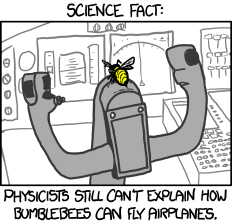There’s also the practicality of getting this deep into it in true pilot training... we have time to hash this out to the Nth degree here, but it has to be condensed almost to the point of being inaccurate in an “FAA approved” 40 hour Private Pilot wonder pilot course of study.
I think that's 100% true and something I battle with as a practical challenge all the time in airman certification. Take a private pilot, especially one that is on an accelerated training track. Three months ago -- some times less -- this pilot had never flown an airplane. Now they're being asked to discuss, among other things, basic aerodynamics.
From the perspective of administering a practical test, the depth and breadth of the discussion on this message board would never occur during oral questioning. I find it challenging enough just to dig into a subject like induced drag and draw some reasonable but still very basic correlations (slow flight / region of reversed command, ground effect, soft field takeoff, etc.) and still have enough time left for the many other AOOs and associated Tasks. But a true understanding of how lift is actually generated is very helpful to a pilot not just in a cerebral way, but in application of skills to flying the aircraft.
Take a commercial pilot applicant. There it is in I.F., "Performance and Limitations," knowledge element CA.I.F.K3, "Aerodynamics." What is a reasonable depth now? In terms of pilot certificates and ratings, this ramps up to its highest level for the addition of a multi-engine rating to a commercial pilot certificate. That's due in part to the fact that the only tasks discussed during the ground portion of the practical test are I.E. and I.F. Aerodynamics are justifiably hit a lot harder for the multiengine rating as a thorough understanding of these concepts is absolutely necessary to operate a multiengine airplane safely. So this is a chance for me to sit down with an applicant and really dig into the aerodynamics. I have found generally good results here because by this point, the applicant has usually already completed three other practical tests at minimum. But at this level of certification if I ask an applicant about how an airfoil develops lift, and the answer includes a jumbled statement like "it takes the air longer to travel over the curved top part of the wing," I don't have high confidence that there's a sufficient level of knowledge there. We'll dig and probe and see what we come up with after that point, but's a a bad way to start because right away they're not recognizing how the wing is actually developing lift.
It’s a shame that the depth of even this discussion just isn’t that practical to get to with most pilots in the training environment, but hard to justify, too.
This discussion and others like it, when not acerbic (and this one doesn't seem to be so) are done outside the bounds of the training regimen and should be pursued by all pilots. I expect you'd agree, since you're here and participating. It's not a profession which is tolerant of punching a time clock or walking out of the airplane at the end of the day and closing off the mind to all matters aviation. There must be a constant interest in expanding knowledge and that happens all the time... which is why the successful professional pilots often have, at their core, a true passion and interest in aviation which goes beyond a nice paycheck.



